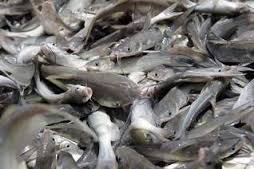
|
||||
| Fisheries :: Culture Fisheries | ||||
Physical characteristics Most catfish are bottom feeders. In general, they are negatively buoyant, which means that they will usually sink rather than float due to a reduced gas bladder and a heavy, bony head. Catfish have a variety of body shapes, though most have a cylindrical body with a flattened ventrum to allow for benthic feeding. A flattened head allows for digging through the substrate as well as perhaps serving as ahydrofoil. Some have a mouth that can expand to a large size and contains no incisiformteeth; catfish generally feed through suction or gulping rather than biting and cutting prey. However, some families, notably Loricariidae and Astroblepidae, have asuckermouth that allows them to fasten themselves to objects in fast-moving water. Catfish also have a maxilla reduced to a support for barbels; this means that they are unable to protrude their mouths as other fish such as carp. Catfish may have up to four pairs of barbels: nasal, maxillary (on each side of mouth), and two pairs of chin barbels, even though pairs of barbels may be absent depending on the species. Many larger catfish also have chemoreceptors across their entire bodies, which means they "taste" anything they touch and "smell" any chemicals in the water. "In catfish, gustation plays a primary role in the orientation and location of food". Because their barbels and chemoreception are more important in detecting food, the eyes on catfish are generally small. Like other ostariophysans, they are characterized by the presence of a Weberian apparatus.Their well-developed Weberian apparatus and reduced gas bladder allow for improved hearing as well as sound production. Catfish have no scales; their bodies are often naked. In some species, the mucus-covered skin is used in cutaneous respiration, where the fish breathes through its skin. In some catfish, the skin is covered in bony plates called scutes; some form of body armor appears in various ways within the order. In loricarioids and in the Asian genus Sisor, the armor is primarily made up of one or more rows of free dermal plates. Similar plates are found in large specimens of Lithodoras. These plates may be supported byvertebral processes, as in scoloplacids and in Sisor, but the processes never fuse to the plates or form any external armor. By contrast, in the subfamily Doumeinae (family Amphiliidae) and in hoplomyzontines (Aspredinidae), the armor is formed solely by expanded vertebral processes that form plates. Finally, the lateral armor of doradids, Sisor, and hoplomyzontines consists of hypertrophied lateral line ossicles with dorsal and ventral lamina Updated on : Feb 2015 |
||||
© All Rights Reserved. TNAU 2009-15. |
||||
